Rope support with tuber: Difference between revisions
m →Building the rope support: - added alternative final state |
Added the operation schematics |
||
| Line 29: | Line 29: | ||
|File:rope_support_atc_step7alt.png | |File:rope_support_atc_step7alt.png | ||
|Alternatively, this is an illustration of the finished setup without the redirecting quickdraw and with unlocked carabiner for Prusik | |Alternatively, this is an illustration of the finished setup without the redirecting quickdraw and with unlocked carabiner for Prusik | ||
}} | |||
== Using the rope support == | |||
As the ATC adds a lot of friction to this system, the pulley gives only 2:1 advantage (only the belay strand part of the rope which is behind the ATC is active during pulling), but 3:1 amount of slack must be taken (as the rope must be still pulled through the ATC). Due to a friction on the carabiner, real world testing done by John Gordino (Alpinesavvy) shown that in reality, it provides only roughly 1.5:1 advantage.<ref name=friction_alpinesavvy>{{cite web | url=https://www.alpinesavvy.com/blog/progress-capture-efficiencies-of-various-devices | title=Progress capture - efficiencies of various devices | publisher=Alpinesavvy LLC | first1=John | last1=Godino | website=AlpineSavvy.com | access-date=27 September 2025 | url-status=live | archive-url=https://web.archive.org/web/20211119020952/https://www.alpinesavvy.com/blog/progress-capture-efficiencies-of-various-devices | archive-date=19 November 2021}}</ref> Than means that for 75 kg climber, 50 kg of weight has still to be pulled up. | |||
{{#invoke:FlexGallery|gallery | |||
|135px | |||
|File:rope_support_atc_pull_step1.png | |||
|Pull the belay rope up | |||
|File:rope_support_atc_pull_step2.png | |||
|After the ATC gets unblocked, additional slack is pulled out of the system | |||
|File:rope_support_atc_pull_step3.png | |||
|Once the pulley is in its top position, grab the belay strand above the carabiner | |||
|File:rope_support_atc_pull_step4.png | |||
|And reset the pulley by sliding the prusik down on the live strand of the rope | |||
}} | }} | ||
Revision as of 18:26, 3 October 2025
| Rope support with tuber | |
|---|---|
| Other names | Rope support |
| Use(s) | Multipitch, mountaineering, rescue |
| Pros | Gives leverage to help with making a hard move |
| Cons | Taking slack is much slower |
Rope support is used in a case when the climber belayed from top needs help by lifting up while performing a hard move. It can be also employed as a support to the second climber during rescue if second climber just needs a bit of help to complete the ascend.
Building the rope support
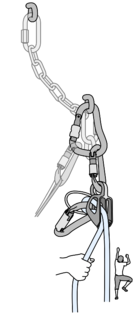
This rope support can be performed only while belaying from above 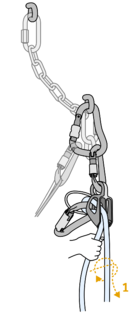
Start with a tie-off of the tuber (1) 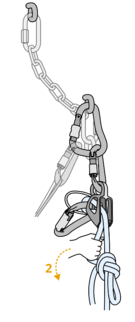
After the tie-off you can let go (2) 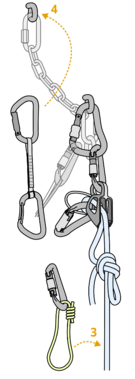
Tie a prusik onto the life strand (3) and place a quickdraw if you want to pull in downwards direction (optional, 4) 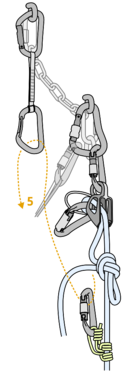
Pull the rope through the carabiner(s) (5) 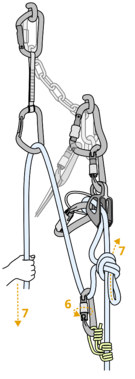
You can close the lock (6) and remove the tie-off while holding the brake strand (7) 
Now you are ready to provide the rope support 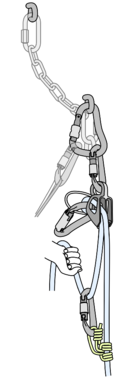
Alternatively, this is an illustration of the finished setup without the redirecting quickdraw and with unlocked carabiner for Prusik
Using the rope support
As the ATC adds a lot of friction to this system, the pulley gives only 2:1 advantage (only the belay strand part of the rope which is behind the ATC is active during pulling), but 3:1 amount of slack must be taken (as the rope must be still pulled through the ATC). Due to a friction on the carabiner, real world testing done by John Gordino (Alpinesavvy) shown that in reality, it provides only roughly 1.5:1 advantage.[1] Than means that for 75 kg climber, 50 kg of weight has still to be pulled up.
References
- ↑ Godino, John. "Progress capture - efficiencies of various devices". AlpineSavvy.com. Alpinesavvy LLC. Archived from the original on 19 November 2021. Retrieved 27 September 2025.



